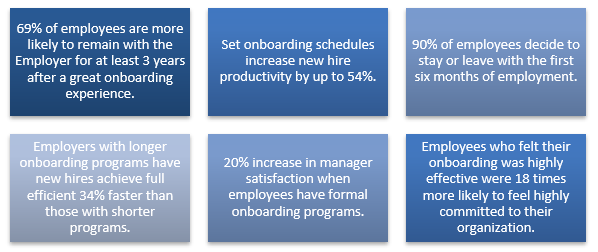Effective Employee Boarding: The Secret to Staff Retention
Are you interested in discovering the secret to staff retention? In this blog, an overview is given on the different types of boarding as well as some key aspects that will help you in making a good onboarding experience for your future employees. A good onboarding experience does not only save costs but also helps you to retain your crucial talent.
It is estimated that replacing an individual employee can cost an employer one-half to two times the employee's annual salary in most cases, and up to 4x salary for specialized staff. Employee turnover directly increases recruitment and training costs, but also has indirect costs on lost productivity, decreased colleague engagement; decreased customer service and an impact on the company’s overall culture. In example of the above, if a company loses 10 employees with an average salary of $40,000 p/a, then the additional replacement costs would range between $200,000 – 800,000 per year. Employee boarding can serve as an excellent tool to prevent employee turnover and in turn prevent these massive expenditures to the Employer.
Facts sheet
So why is effective boarding important? Studies have shown that 50% of external senior staff hires fail within 18 months of employment and 1/3rd of new employees leave their company within the first 90 days.
Meanwhile effective boarding have been shown to have a wide range of benefits with some of the most eye-catching statistics recorded below.

Types of boarding
Employee boarding, or academically known as industrial socialization, is the process through which new employees are trained in order to increase their knowledge about the organization, its norms, rules and other internal dynamics in order to enable them function effectively as employees, members and stakeholders, and in essence is the process of changing them from outsiders to company insiders.
Industrial socialization most commonly takes the form of traditional onboarding, that is to say training which takes place in the first 30-60-90 days of employment, however this process can also take place as preboarding (which takes place before the first day of work but after the contract is signed or even during the final stages of the interview process), reboarding (which takes place well after the initial onboarding process is completed but ensures that staff are aware of business changes or new processes) and cross-boarding (filling vacant positions by promoting already boarded employees). A special mention should be made to offboarding which focuses on ending the employment relationship without any loose end as each time an employee exits a business, there’s the potential for something to be left unfinished, presenting dangerous security breaches and potential data leaks.
Boarding can be broadly categorized in five different ways:
- Operational boarding – providing employees with the tools and equipment necessary to carry out their job.
- Knowledge boarding – transferring the knowledge needed to do the job.
- Performance boarding - New starters should be set short-term objectives that are achievable from day one. This way, they can understand the focus of their job role and get stuck in straight away. These achievements can also be used to evaluate the entire probation period.
- Social boarding - Social Onboarding is about people feeling included, understood and known as a person. A buddy scheme is a useful tool as people don’t often want to admit to their manager that they do not understand something.
- Talent boarding – Moving talent around the organization can help with overall retention. Knowing peoples skills, knowledge and experience from day one and having it recorded in a talent search system can be a powerful tool for the company in the long run.
What makes a good onboarding experience
There is no one-size-fits-all approach to designing a boarding program that will fit with your company’s needs and culture, however a general framework which is adapted to the company’s needs will deliver the best results. Below are some important steps when designing such a program which can help your program succeed:
| 1. Welcome your new hire |
Build off the excitement of the offer and reinforce the candidate’s decision to join your company by creating a personalized welcome. Also, do not forget to announce the newest addition to the rest of the team, so they can welcome the new hire too and consider assigning a buddy for the new hire so that there is someone who the new hire can rely on and ease the transition during the “Yes to Desk” phase. |
| 2. Start preboarding and onboarding as soon as possible | Preboarding can get all of the required paperwork out of the way as soon as possible. You can also provide the most recent employee handbook, along with any company policies or information on the company’s culture as this will help the employee prepare themselves for what to expect on their first day. |
|
3. Continually brainstorm and improve existing programs |
A good boarding program is the result of a collaborative effort. Have teams customize the onboarding framework to their department, and consider points such as What is the best way to make employee introductions or how will you share company, team and department specific knowledge. |
|
4. Use a new hire checklist, provide handbooks, policies and company brochures |
Designing a repeatable employee onboarding process can help eliminate administrative misses and ensure a smoother process overall. HRIS and employee onboarding software can automate many tasks in the onboarding process and ensure that there are no missed steps in the welcoming these new team members. |
|
5. Try to create a great first day and first week |
There is more to onboarding than completing administrative tasks and providing basic training, and employers should ensure that new hires leave their job on the first day with a positive, lasting impression. Simple gestures such as giving an office tour before heading to a team lunch or having a coffee with their manager or buddy can go a long way. |
|
6. Plan regular check-ins, not just the 30-60-90 day checks |
33% of employees leave their jobs within the first 90 days, so it’s important to check in regularly to learn about any issues. Plan for 5-minute check-ins around days 1, 7, 14, 30, 45, 60, 75 and 90 and then periodically thereafter. |
|
7. Ask for feedback from new hires |
Designing a world class employee onboarding program is an ongoing commitment. Find what new hires like and dislike about your program, and what you could have done better. Then, make sure you actually use the feedback to make improvements. Failing to improve and adapt onboarding programs will result in the program falling behind industry trends and employee expectations. |
Conclusion
Employees are looking for opportunities to work with organizations that are going to invest in them. Great boarding programs shows employees that you want them to be successful. Boarding benefits both parties, as it provides the necessary training and support employees need to work with innovation, creativity, while also boosting retention and in turn cutting unnecessary expenditure on replacing departing employees.
Do you need help with employee retention in Europe? Our European HR Consultants would love to think along.
About EuroDev
EuroDev, established in 1996 with offices in The Netherlands, has a single, defined purpose to help mid-sized North American companies expand their business in Europe. We have created a proven, successful business development model and since our founding, have partnered with over 300 companies to help them define and meet their European business goals. Services provided include Sales Outsourcing, HR Outsourcing and Digital Marketing.
Disclaimer: While we strive to provide accurate and timely information, please note that HR policies and regulations can change frequently. It is recommended that you seek guidance from our HR consultants to ensure that the data presented here is current and accurate.
Category
Related articles
-

Notice Period and Severance Pay in EU Countries in 2025
8 April 2025While specific rules vary from one country to another, they are typically shaped by national...
Read more -

Unlimited Vacation: Who Offers It and Does It Really Work?
3 April 2025Discover the benefits and challenges of unlimited vacation policies and how companies successfully...
Read more -

Building a Dream Team: Comprehensive Guide |Part II
24 March 2025It requires careful planning, nurturing relationships, and a deep understanding of the elements...
Read more

